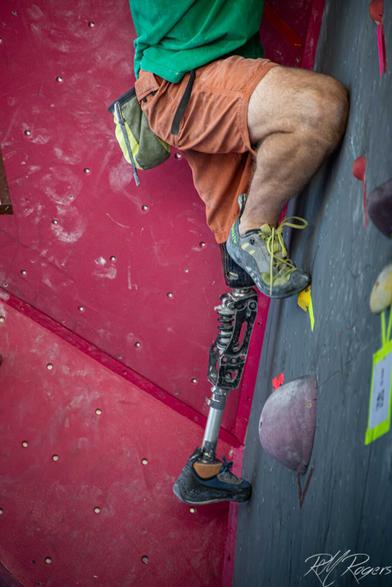Recent searches
Search options
#prosthesis
Ukrainian war veterans Anastasia and Pavel are photographed on their wedding day. The couple met at the ‘Superhumans’ centre, an orthopaedic clinic in Kyiv that specialises in the treatment and rehabilitation of those who have lost limbs and use a #prosthesis.
Photograph: Libkos/Getty Images
Oleh Slyvar is 26 years old, and for 12 of them he danced in the Verkhovynka #dancing group.
He joined the #Ukraine National Guard in the summer of 2022 and fought in the #Donetsk region. Oleh sustained numerous shrapnel wounds to his leg during a mortar assault.
Oleh received a modern #prosthesis with an electronic knee, which allowed him to #dance again.
The incredible strength of spirit of Ukrainian defenders inspires to fight and move towards our victory.
"Here we present an injectable tissue #prosthesis with instantaneous bidirectional electrical conduction in the #neuromuscular system. The soft and injectable prosthesis is composed of a biocompatible #hydrogel with unique phenylborate-mediated multiple crosslinking, such as irreversible yet freely rearrangeable biphenyl bonds and reversible coordinate bonds with conductive gold #nanoparticles formed in situ by cross-coupling"
Jarl Varg has entered the chat! #norsemen #prosthesis
Incoming new character in my comics with legs prosthesis and gosh it's so difficult finding a design that is esthetical but also kinda realistic/practical. It will never be 100% realistic but finding the right balance between appealing visual and universe consistency... #CharacterDesign #Prosthesis #Comics
Feel free to play the Bionic Woman theme in your head while reading this!
#bionics #prosthesis #artificiallimbs #medicaltechnology
Woman's Experimental Bionic Hand Passes Major Test With Flying Colors https://gizmodo.com/bionic-mia-hand-prosthetic-amputee-phantom-pain-1850919751
For comparison the results of the different down-sampling methods of Figure 5 in the paper, now extended with a 4th column for the down-sampling method of The vOICe for Android; many thanks to Diego Ghezzi and Franklin Leong for providing original images https://www.linkedin.com/in/franklin-leong-573012161/
"When these goals are achieved, we will be ready to further test the new technology in humans, and we aim to test the new version of the implant in humans in the coming two to three years." #blind #blindness #prosthesis
For all y'all wondering how my #surgery recovery is doing, one #prosthesis popped out soon after surgery and I get to spend the next few weeks deciding how soon or whether to get it put back. Otherwise, I'm doing about as well as can be expected given the damage leading up to this.
#arthroplasty #rheumatoid #mcp #fakeknuckles
Cortical layering disrupts multi-electrode current steering https://iopscience.iop.org/article/10.1088/1741-2552/acdaf7 "Multi-electrode stimulation is not suitable for targeted activation of layers using current steering", but may reduce risk of #seizures by lowering activation #thresholds; brain implant, #visual cortical #prosthesis, #BCI #NeuroTech #blindness
(YouTube) #TEDx talk: How a #brain #prosthesis could help the #blind https://www.youtube.com/watch?v=Pps9L0Ohe-4 by Pieter Roelfsema and Hein Noortman; #TEDxDenHelder #BCI #NeuroTech
Intraretinal stimulation with high density carbon fiber microelectrodes https://ieeexplore.ieee.org/document/10123735 by James Weiland et al.; "modification of pulse amplitudes and electrode depths can create small and focal responses around the active electrode"; #retinal #implant, retinal #prosthesis
(Powerpoint) Presentation given at the Durham workshop on "New directions in #sensory #substitution and #augmentation", May 18, 2023 https://www.seeingwithsound.com/extra/Durham2023.pptx #visual #prosthesis, #BCI, #blind, #blindness, #crossmodal #perception, #vision
Q1 2023, no change: "#Cortigent continues to assess strategic options for advancing its pioneering #neuromodulation technology including the #Orion Visual #Cortical #Prosthesis System for providing #artificial #vision to profoundly #blind individuals" https://www.sec.gov/Archives/edgar/data/1266806/000175392623000657/g083544_ex99-2.htm $VANI
Development of polymeric blue prosthetic retina photoreceptors https://link.springer.com/article/10.1557/s43580-023-00525-1 Sub-#retinal #implant; #prosthesis #blindness
A fun example of the usefulness and necessity of temporal data augmentation in a #BCI setting (#BrainGate2 pilot clinical trial): Translating deep learning to neuroprosthetic control https://www.biorxiv.org/content/10.1101/2023.04.21.537581v1 applying dilation/compression and re-ordering of training data to prevent overfitting; #brain #prosthesis #NeuroTech #AI


